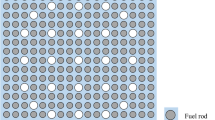Abstract
Higher conversion efficiencies require high operation temperatures that are difficult to obtain due to the actual thermo-physical properties of the nuclear fuels. The initial intrinsic thermal conductivity of the actual fuel pellets, mainly ceramics like structures (oxides, nitrides, carbides, MOX, beads) is low. The center of the pellet is near melting temperature while the cladding operation temperature has to be low. The fission products deposition and burnup effects are further dimming the thermal conductivity. More the cooling agent’s chemical reactivity increases with temperature is another main reasons of keeping the operation temperature low. The usage of a hetero-structure of solid fuel soaked into a drain fluid is increasing the thermal conductivity. Properly shaped beads structure drives to the possibility of preventing most of the fission products of being stored inside the fuel lattice deteriorating its properties, being drained outside the nuclear reactor. This changes inspired from the nature, makes the nuclear reactor resembling with a plant having self cleaning and curing properties while operating at higher temperatures. Immersing the fuel into liquid metal higher operation temperatures are allowed due to increase in thermal conductivity by 3 to 20 times. Making the fuel beads shorter than the range of fission products, their trajectories end in the drain liquid that is tolerant to nuclear recoils damage. Due to better thermal conductivity the temperature field differences inside the nuclear reactor becomes smaller, allowing the operating temperature to rise significantly without safety concerns. There is possible to continuously remove the fission products by smoothly circulating the drain liquid. The low flow is needed to give time to short lives fission products to decay inside the reactor highly shielded volume. There are several fissionable materials and drain liquids matching which assure high operation temperatures, and allow He cooling, and high temperatures gas turbines cycles. The conversion efficiency might be higher than 70% depending on the chosen actinide / drain-liquid / cooling-liquid combination. The new concept on fission products continuous release and separation minimizes the waste and the total radioactivity stored inside the reactor to few weeks integrated operation amount remaining constant over the time. That makes the fuel’s remnant radioactivity lower by a factor >100 than the actual reactors level. The fuel reactivity might be controlled by poisoning and transmutation or by assuring specific reactive geometries which to allow a ultrahigh burnup without the need of over-criticality loads. The fuel’s deformability opens the way for interesting applications. The advantages of micro structured nuclear fuel are higher thermal conductivity, fission products removal, appropriate reactivity, higher efficiencies and longer fuel life.
Similar content being viewed by others
References
Marquis J., Novel Integrated Reactor/Power Conversion System. NERI, 1999. 99–0198(1): p. 2.
POPA-SIMIL L., Report on Nuclear Fuel’s Thermal Conductivity Modeling and Measurement - Urania. LANL Reports, 2004. LA-UR-04-5194(1): p. 1–45.
FINK J.K., Thermal Conductivity and Thermal Diffusivity of Solid UO2. International Nuclear Safety Center (INSC), 2004. Preliminary Recommendation.(anl.gov): p. 28.
LANNING D. D., C.L.P.,, FRAPCON-3: Modifications to Fuel Rod Material Properties and Performance Models for High-Burnup Application. Nuclear Regulatory Commission, NUREG/CR-6534 U.S., 1997. 1((PNNL-11513)): p. 1–124.
YANG J.H., K.W.K., KUN W.S., et al.,, Fabrication and Thermal Conductivity of (Th,U)O2 Pellets. Nuclear Technology, 2004. 147(1): p. 113–119.
INOUE M., Thermal conductivity of uranium-plutonium oxide fuel for fast reactors. Journal of Nuclear Materials, 2000. 282((2/3): p. 186–95.
MINATO K., A.M., TAKANO M., ARAI Y., NAKAJIMA K., ITOH A., OGAWA T.,, Fabrication of nitride fuels for transmutation of minor actinides. Journal of Nuclear Materials, 2003. 320: p. 1–2.
SPRIGGS G. D., Criticality of uranyl-nitrate solution containing boric acid. Transactions of the American Nuclear Society, 1985. 50: p. 304–5.
VERALL R. A., V.M.D., KRSTIC V. D.,, Silicon carbide as an inert-matrix for a thermal reactor fuel. Journal of Nuclear Materials, 1999. 274: p. 54.
DZIADOSZ D., A.T.N., SAGLAM M., SAPYATA J.J.,, Weapons-Grade Plutonium-Thorium PWR Assembly Design and Core Safety Analysis. Nuclear Technology, 2004. 147(1): p. 69–83.
BURAKOV B., A.E., Immobilization of Excess Weapons Plutonium in Russia: A Review of LLNL Contract Work. Proc. Meet. For Coordination and Review of Work,, 2001. UCRL-ID-143846: p. 229–234.
DEGUELDRE C., A.T., LEE Y. W.,, Thermal conductivity of zirconia based inert matrix fuel: use and abuse of the formal models for testing new experimental data. Journal of Nuclear Materials, 2003. 319: p. 6–14.
MOGENSEN M., P.J.H., WALKER C. T.,, Behaviour of fission gas in the rim region of high burn-up UO{sub 2} fuel pellets with particular reference to results from an XRF investigation. Journal of Nuclear Materials, 1999. 264: p. 1–2.
WHITE R. J., The development of grain-face porosity in irradiated oxide fuel. Journal of Nuclear Materials, 2004. 325(1): p. 61–77.
MAUCEC M., P.A., GLUMAC B., JERAJ R.,, Criticality safety study of NPP Krsko spent fuel pool with Monte Carlo computer code MCNP4A. 1994.
BOWMAN C. D., V.F., Accelerator-driven thermal spectrum system for weapons plutonium destruction. Transactions of the American Nuclear Society, 1993. 69: p. 102–3.
LOAIZA D.J, S.W., Criticality Data for Spherical 235U, 239Pu, and 237Np Systems Reflector-Moderated by Low Capturing-Moderator Materials. Nuclear Technology, 2004. 146(2): p. 143–154.
RIMPAULT G., The ERANOS Code and Data System for Reactor Neutronics Analysis. Proc. Int. Conf. on the Physics of Fuel Cycles and Advanced Nuclear Systems, PHYSOR 2002, Seoul, Korea, 2002.
ZIGLER J.F., SRIM. IBM-web, 2003.
VALENIUS J., Transmutation Course. University Web, 2004. Thermal conductivity.
Author information
Authors and Affiliations
Rights and permissions
About this article
Cite this article
Popa-Simil, L., Vasilescu, G. Solid Micro-Beads Hetero-Structure Fuel for Ultra-High Temperature Applications. MRS Online Proceedings Library 981, 710 (2006). https://doi.org/10.1557/PROC-981-0981-JJ07-10
Received:
Accepted:
Published:
DOI: https://doi.org/10.1557/PROC-981-0981-JJ07-10




